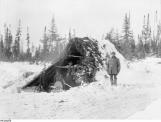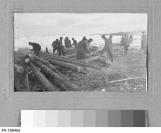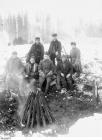1
A Trip North, but not a Publicity TripBy 1915, the second year of World War I, Sallows had made several trips to Northern Ontario. The trips were mainly to take promotional views of Algonquin Park, the north country that the Grand Trunk or Canadian National railways ran through or document the work of the J.R. Booth Lumber company. But in 1915, according to dates written in pencil on the back of a series of photographs, Sallows went north for a very different reason.
2
Pier at Spirit Lake, Ontario - WWI internment camp1915
Spirit Lake - near town of Amos, Quebec
 Credits:
Credits:Library & Archives Canada, Ottawa, Ontario
3
Where was Spirit Lake?In January 1915, the Spirit Lake Internment Camp began, when the first 109 Austrian prisoners-of-war (POWs) arrived from Montreal. Between February and March of the same year, another 518 arrived. By the end of 1915, there were over 1,210 POWs, most of Austrian descent, interred at Spirit Lake.
The camp, located 7.5 kilometers west of Amos, Quebec (only settled in 1912), was in the center of the Abitibi colonization district on the shores of a lake. The name, Spirit Lake, was used by the local natives in reference to a local legend that a huge star appeared above the lake as a sign from the Great Spirit. The French name for the lake was Lac Beauchamp. The camp was situated at the end of the Transcontinental Railway line into the area.
4
Pier at Spirit Lake Internment Camp1915
Spirit Lake - near town of Amos, Quebec
 Credits:
Credits:Library and Archives Canada, Ottawa, Ontario
5
Who was interred at Spirit Lake?Spirit Lake Internment Camp was created in an area targeted for colonization, in the middle of the northern Quebec wilderness. To attract settlers, land needed to be cleared, roads opened and some form of civilization established. And that required manpower.
The Austrians who were transported to Spirit Lake came first from the urban city of Montreal. When war broke out with Austria-Hungary as the enemy against the British crown, thus Canada's enemy, those of Austrian/Hungarian descent were looked upon with suspicion. When the War Measures Act of 1914 was passed, the government of Canada legalized the arrest, imprisonment (or internment as they prefered to call it), and confiscation of the liberties and properties of any suspected individuals.Men who had immigrated to Canada and found jobs in factories and businesses across the city were fired from their jobs. Their accents marked them as suspicious foreigners. They could not feed themselves or their families. The Canadian government and public recoiled from them.
The suspicion created a problem in the cities where there was a growing wave of unemployment and destitution. To solve three problems, the internment camps were created. Manpower was acquired to clear the northern colonization area, potentially dangerous enemy aliens were put under military supervision and the cities' unemployed foreigners removed. Some even volunteered to escape the dangerous patriotic zeal and violence against all things & people foreign.
Life at Spirit Lake was no escape.
6
Spirit Lake Internment Camp - a shelter1915
Spirit Lake - near town of Amos, Quebec
 Credits:
Credits:Library and Archives Canada, Ottawa, Ontario
7
Spirit Lake Internment Camp - POWs at work1915
Spirit Lake - near town of Amos, Quebec
 Credits:
Credits:Library and Archives Canada, Ottawa, Ontario
8
Spirit Lake Internment Camp - POWs at work and their guards1915
Spirit Lake - near town of Amos, Quebec
 Credits:
Credits:Library and Archives Canada, Ottawa, Ontario
9
Life at Spirit LakeInternment began with a government promise of up to 100 acres of land in the country around the lake once the war was over. And so over 700 men worked to clear the forests and make way for government model farms and build log buildings. Some of those interred, POWs, brought family from Montreal north to Spirit Lake, necessitating the construction of a married prisoners' camp, separate from the main camp.
Upon arrival at Spirit Lake it was recorded that each prisoner received, "a soft felt hat, a fur lined cap, two inside and two outside woolen shirts, a canvas, sheepskin or mackinaw coat, working trousers, two suits of woolen underwear, two pairs of heavy woolen socks, a pair of woolen gloves with leather pullovers, army boots and winter moccasins." In the photographs, note the presence of military guards with rifles and their apparel, in comparison with that of the POWs.
In October 1916, the POWs of Spirit Lake went on strike due to deplorable working and living conditions. It was a protest against rotten food, poorly heated living quarters and forced labour without wages (they were to receive 25 cents a day, as wage).
Few, if any, of those who served at Spirit Lake for the 2 years it was in operation, stayed to settle in the area. Most were dispersed to other internment camps and labour assignments across Canada. In 1916, in response to dire labour shortages, POWs were sent to work for large government & business works - 32 went to the Minto Coal Co. of New Brunswick, 43 to the Asbestos Corporation, 50 to the Canadian National Railway, 100 to the National Transcontinental Railway, 172 to the Canadian Pacific Railway and 219 to the Welland Ship Canal.
10
Spirit Lake Internment Camp - POWs & their guards around a fire1915
Spirit Lake - near town of Amos, Quebec
 Credits:
Credits:Library and Archives Canada, Ottawa, Ontario
11
Spirit Lake Internment Camp - cutting logs in the bush1915
Spirit Lake - near town of Amos, Quebec
 Credits:
Credits:Library and Archives Canada, Ottawa, Ontario
12
Spirit Lake Internment Camp - cutting ice on the lake1915
Spirit Lake - near town of Amos, Quebec
 Credits:
Credits:Library and Archives Canada, Ottawa, Ontario
13
Spirit Lake Internment Camp-S.M. Prouse & Capt. Able at married POWs village1915
Spirit Lake - near town of Amos, Quebec
 Credits:
Credits:Library and Archives Canada, Ottawa, Ontario
14
Spirit Lake Internment Camp - Prisoners returning from Sunday morning parade1915
Spirit Lake - near town of Amos, Quebec
 Credits:
Credits:Library and Archives Canada, Ottawa, Ontario